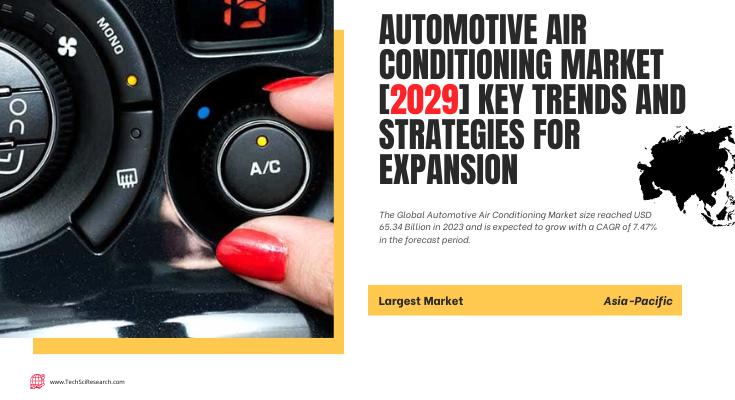According to TechSci Research report, “Automotive Air Conditioning Market – Global Industry Size, Share, Trends, Competition Forecast & Opportunities, 2029”, the Global Automotive Air Conditioning Market stood at USD 65.34 Billion in 2023 and is anticipated to grow with a CAGR of 7.47% in the forecast period, 2025-2029. The global automotive air conditioning market has witnessed significant growth and evolution over the years, driven by a combination of technological advancements, changing consumer preferences, and regulatory requirements. This market encompasses the manufacturing, distribution, and servicing of air conditioning systems specifically designed for automobiles, catering to both passenger and commercial vehicles. As the automotive industry continues to expand and innovate, the demand for efficient and advanced air conditioning solutions has become more pronounced, contributing to the overall growth of the market.
One of the key drivers of the global automotive air conditioning market is the increasing global temperature and climate change concerns. As temperatures rise, the demand for effective cooling systems in vehicles has surged, not only for comfort but also for safety reasons. Extreme heat conditions can affect driver concentration and vehicle performance, making reliable air conditioning systems essential. This growing awareness of the importance of in-car comfort and the need for temperature control has spurred the adoption of advanced air conditioning technologies.
The automotive air conditioning market has also been influenced by regulatory initiatives aimed at reducing greenhouse gas emissions. Governments worldwide are implementing stringent emission standards, pushing automotive manufacturers to develop more fuel-efficient vehicles. This, in turn, has led to the integration of advanced air conditioning systems that are not only efficient in cooling but also contribute to overall energy efficiency. The focus on sustainability and eco-friendly technologies has propelled the development of systems with reduced environmental impact.
Technological advancements play a pivotal role in shaping the landscape of the automotive air conditioning market. The industry has witnessed a transition from traditional refrigerants to environmentally friendly alternatives. The adoption of new refrigerants with lower global warming potential (GWP) has become a focal point for manufacturers. Additionally, the integration of smart and connected technologies in air conditioning systems has gained traction. Smart air conditioning systems enable users to control and monitor temperature settings remotely, enhancing the overall user experience.
The market is also characterized by a growing emphasis on electric and hybrid vehicles. As the automotive industry undergoes a paradigm shift towards sustainable and electric mobility, air conditioning systems are being redesigned to meet the specific requirements of electric vehicles. The efficient cooling of batteries and the overall thermal management of electric vehicles are critical factors, and manufacturers are investing in research and development to address these challenges.
Geographically, the automotive air conditioning market exhibits variations in demand and growth patterns across different regions. Developing economies with a rising middle class, such as those in Asia-Pacific and Latin America, are experiencing robust growth in automotive sales, contributing significantly to the demand for air conditioning systems. Meanwhile, developed markets in North America and Europe witness a steady replacement demand for air conditioning units in existing vehicles, driven by the desire for upgraded and more efficient systems.
Challenges also exist within the automotive air conditioning market, with cost considerations being a prominent factor. The integration of advanced technologies and eco-friendly refrigerants often results in higher production costs, impacting the pricing of vehicles equipped with these systems. Striking a balance between offering innovative features and maintaining affordability is a constant challenge for manufacturers.
The global automotive air conditioning market is dynamic and evolving, shaped by factors such as climate change, regulatory dynamics, technological advancements, and shifts in consumer preferences. The industry is witnessing a transition towards more sustainable and efficient solutions, driven by the need for environmental responsibility and the growing demand for comfort and safety in vehicles. As automotive manufacturers continue to invest in research and development, the market is likely to see further innovations that redefine the role of air conditioning systems in modern vehicles.
Browse over market data Figures spread through 180 Pages and an in-depth TOC on “ Global Automotive Air Conditioning Market.” @ https://www.techsciresearch.com/report/automotive-air-conditioning-market/2640.html
North America holds a prominent position in the global automotive air conditioning market. The region is characterized by a high standard of living, a well-established automotive industry, and a strong consumer preference for advanced automotive technologies. In the United States and Canada, the demand for vehicles with advanced air conditioning systems has been steadily increasing. Stringent regulations related to vehicle emissions and fuel efficiency have also driven the adoption of more energy-efficient and environmentally friendly air conditioning technologies.
The European and CIS (Commonwealth of Independent States) regions have witnessed a steady growth in the automotive air conditioning market. Europe, being a major hub for automotive manufacturing, has a strong demand for advanced comfort features in vehicles. Stringent environmental regulations and a growing emphasis on reducing greenhouse gas emissions have led to increased adoption of eco-friendly and energy-efficient air conditioning systems.
The Asia Pacific region is a key player in the global automotive air conditioning market, driven by factors such as rapid urbanization, a growing middle-class population, and increasing disposable income. Countries like China, Japan, South Korea, and India are major contributors to the market’s growth. The booming automotive industry in the region, coupled with the rising demand for passenger vehicles, has significantly boosted the adoption of air conditioning systems.
South America exhibits unique dynamics in the automotive air conditioning market. Economic factors, political stability, and infrastructure development influence the growth of the automotive industry in countries like Brazil and Argentina. The demand for air conditioning systems in vehicles is rising due to the region’s tropical climate, where temperatures can soar.
While economic challenges may impact the purchasing power of consumers, there is still a growing trend toward adopting modern vehicles with advanced comfort features. Market players are strategizing to provide affordable yet efficient air conditioning solutions to address the specific needs of the South American market.
The Middle East and Africa region present opportunities and challenges for the automotive air conditioning market. High temperatures in the Middle East, coupled with a growing automotive sector, drive the demand for effective cooling solutions. Luxury vehicles in this region often come equipped with advanced air conditioning systems, contributing to the market’s growth. In Africa, factors such as economic development, infrastructure improvement, and urbanization influence the automotive industry. The market in this region is characterized by a mix of traditional and modern preferences. As the automotive infrastructure evolves, there is a potential for increased adoption of air conditioning systems in vehicles.
Major companies operating in the Global Automotive Air Conditioning Market are:
- Denso Corporation
- Mahle Behr GmbH
- Valeo S.A.
- Hanon Systems
- Calsonic Kansei Corporation
- Keihin Corporation
- Sanden Corporation
- Subros Ltd.
- Mitsubishi Heavy Industries Ltd.
Download Free Sample Report @ https://www.techsciresearch.com/sample-report.aspx?cid=2640
Customers can also request 10% free customization in this report.
“The global automotive air conditioning market is poised for significant growth, driven by several key factors. Increasing demand for passenger comfort, rising disposable incomes, and a surge in automobile production are primary drivers. Moreover, growing awareness of environmental concerns has led to a greater emphasis on energy-efficient and eco-friendly air conditioning systems in vehicles. With continuous innovations and the adoption of sustainable solutions expected to shape the future of automotive air conditioning, ensuring a comfortable and environmentally conscious driving experience” said Mr. Karan Chechi, Research Director with TechSci Research, a research-based management consulting firm.
“Automotive Air Conditioning Market – Global Industry Size, Share, Trends Opportunity, and Forecast, Segmented By Technology (Manual and Automatic), By Component (Compressor, Evaporator, Receiver, and Condenser), By Vehicle Type (Passenger Cars, Commercial Vehicles), By Region, Competition, 2019-2029”, has evaluated the future growth potential of Global Automotive Air Conditioning Market and provides statistics & information on market size, structure, and future market growth. The report intends to provide cutting-edge market intelligence and help decision-makers take sound investment decisions. Besides, the report also identifies and analyzes the emerging trends along with essential drivers, challenges, and opportunities in the Global Automotive Air Conditioning Market.
You may also read:
Fibrin Sealant Market [2028] – Analysis, Trends, & Insights
Ocular Adhesives & Sealants Adhesives Market Advancements and Business Opportunities [2028]
India Automotive Camera Market – A Comprehensive Report [2029]
India Electric Commercial Vehicle Market [2029] Exploring Potential, Growth, Future & Trends
India Automotive Bearing Market [2029] Key Trends and Strategies for Expansion
Table of Content-Automotive Air Conditioning Market
- Introduction
1.1. Product Overview
1.2. Key Highlights of the Report
1.3. Market Coverage
1.4. Market Segments Covered
1.5. Research Tenure Considered
- Research Methodology
2.1. Objective of the Study
2.2. Baseline Methodology
2.3. Key Industry Partners
2.4. Major Association and Secondary Sources
2.5. Forecasting Methodology
2.6. Data Triangulation & Validation
2.7. Assumptions and Limitations
- Executive Summary
3.1. Market Overview
3.2. Market Forecast
3.3. Key Regions
3.4. Key Segments
- Impact of COVID-19 on Global Automotive Air Conditioning Market
- Global Automotive Air Conditioning Market Outlook
5.1. Market Size & Forecast
5.1.1. By Value
5.2. Market Share & Forecast
5.2.1. By Technology Market Share Analysis (Manual and Automatic)
5.2.2. By Component Market Share Analysis (Compressor, Evaporator, Receiver, and Condenser)
5.2.3. By Vehicle Type Market Share Analysis (Passenger Cars, Commercial Vehicles)
5.2.4. By Regional Market Share Analysis
5.2.4.1. Asia-Pacific Market Share Analysis
5.2.4.2. Europe & CIS Market Share Analysis
5.2.4.3. North America Market Share Analysis
5.2.4.4. South America Market Share Analysis
5.2.4.5. Middle East & Africa Market Share Analysis
5.2.5. By Company Market Share Analysis (Top 5 Companies, Others – By Value, 2023)
5.3. Global Automotive Air Conditioning Market Mapping & Opportunity Assessment
5.3.1. By Technology Market Mapping & Opportunity Assessment
5.3.2. By Component Market Mapping & Opportunity Assessment
5.3.3. By Vehicle Type Market Mapping & Opportunity Assessment
5.3.4. By Regional Market Mapping & Opportunity Assessment
- Asia-Pacific Automotive Air Conditioning Market Outlook
6.1. Market Size & Forecast
6.1.1. By Value
6.2. Market Share & Forecast
6.2.1. By Technology Market Share Analysis
6.2.2. By Component Market Share Analysis
6.2.3. By Vehicle Type Market Share Analysis
6.2.4. By Country Market Share Analysis
6.2.4.1. China Market Share Analysis
6.2.4.2. India Market Share Analysis
6.2.4.3. Japan Market Share Analysis
6.2.4.4. Indonesia Market Share Analysis
6.2.4.5. Thailand Market Share Analysis
6.2.4.6. South Korea Market Share Analysis
6.2.4.7. Australia Market Share Analysis
6.2.4.8. Rest of Asia-Pacific Market Share Analysis
6.3. Asia-Pacific: Country Analysis
6.3.1. China Automotive Air Conditioning Market Outlook
6.3.1.1. Market Size & Forecast
6.3.1.1.1. By Value
6.3.1.2. Market Share & Forecast
6.3.1.2.1. By Technology Market Share Analysis
6.3.1.2.2. By Component Market Share Analysis
6.3.1.2.3. By Vehicle Type Market Share Analysis


